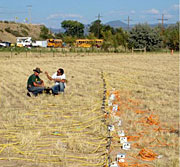- Number 299 |
- November 9, 2009
'X-ray vision' on microbes that halt uranium deep underground

Kenneth Williams and graduate
student Adrian Flores Orozco
collect data on microbe’s behavior
at the Rifle site using SSIP.
Like Superman, scientists can now "see" through layers of earth and rock. Unlike the Man of Steel, researchers are using this new ability to learn how microbes are halting uranium’s movement in groundwater underneath nuclear weapons sites. This new ability is known as surface spectral-induced polarization approach or SSIP. It was created by a team from Lawrence Berkeley National Laboratory, Pacific Northwest National Laboratory, the University of Bonn, and the University of California, Berkeley. The SSIP approach lets scientists monitor the subsurface—areas as small as 0.3 meters—without using groundwater wells. In devising this technique, the team used resources at DOE’s EMSL and the field demonstration site near Rifle, Colorado.
[Kristin Manke, 509.372.6011,
kristin.manke@pnl.gov]
